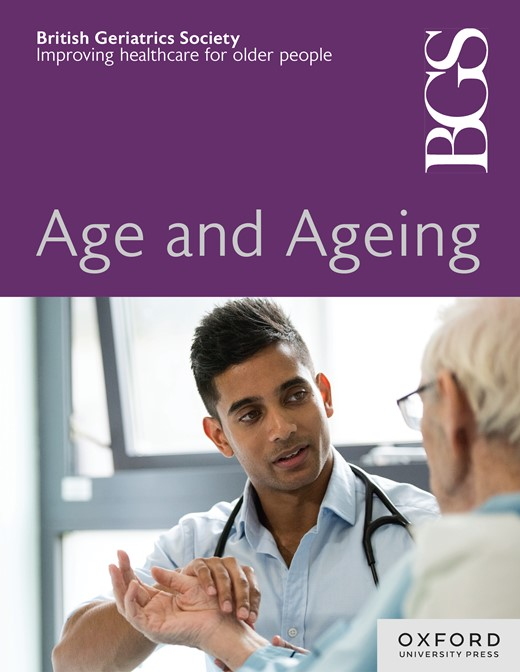Oropharyngeal Staphylococcus aureus is linked to higher mortality in long-term aged care residents
IF 6
2区 医学
Q1 GERIATRICS & GERONTOLOGY
引用次数: 0
Abstract
Background Biological ageing, healthcare interactions, and pharmaceutical and environmental exposures in later life alter the characteristics of the oropharyngeal (OP) microbiome. These changes, including an increased susceptibility to colonisation by pathobiont species, have been linked with diverse health outcomes. Objectives To investigate the relationship between OP microbiome characteristics and all-cause mortality in long-term aged care residents. Methods OP swabs were collected from 190 residents of five aged care facilities in South Australia. Microbiota composition was assessed by shotgun metagenomics and related to health outcomes during a 12-month follow-up period. OP carriage of Staphylococcus aureus and methicillin resistance was confirmed by qPCR. Results OP carriage of S. aureus was identified in 13 (6.8%) residents. Detection of S. aureus was significantly associated with an increased risk of mortality (adjusted HR [95% CI]: 9.7 [3.8–24.9], P < .0001), compared with non-carriers, independent of methicillin resistance. Staphylococcus aureus carriage demonstrated a stronger association with mortality risk than the total number of comorbidities at the univariate level (S. aureus HR [95% CI]: 7.2 [3.4–15.5], P < .0001 vs. comorbidity count HR [95% CI]: 1.1 [1.0–1.3], P = .03), and remained significant after multivariable adjustment. Staphylococcus aureus detection was significantly associated with total number of comorbidities (adjusted OR [95% CI]: 1.4 [1.0–2.0], P = .04). Conclusion OP S. aureus carriage predicts all-cause mortality in long-term aged care. We speculate that S. aureus carriage represents a marker of general health, including prior healthcare exposures. OP S. aureus carriage could contribute to estimations of general health in older individuals and thereby inform care strategies.口咽金黄色葡萄球菌与长期老年护理居民较高的死亡率有关
生物老化、医疗保健相互作用以及晚年的药物和环境暴露会改变口咽(OP)微生物组的特征。这些变化,包括对病原体物种定殖的易感性增加,与各种健康结果有关。目的探讨长期护理老年人OP菌群特征与全因死亡率的关系。方法收集南澳5家老年护理机构190名老人的OP拭子。通过霰弹枪宏基因组学评估微生物群组成,并在12个月的随访期间与健康结果相关。qPCR证实金黄色葡萄球菌携带OP,并对甲氧西林耐药。结果13例(6.8%)居民检出OP携带金黄色葡萄球菌。金黄色葡萄球菌的检测与死亡风险的增加显著相关(校正HR [95% CI]: 9.7 [3.8-24.9], P <;0.0001),与非携带者相比,与甲氧西林耐药性无关。在单变量水平上,金黄色葡萄球菌携带与死亡风险的相关性强于共病总数(金黄色葡萄球菌HR [95% CI]: 7.2 [3.4-15.5], P <;.0001 vs合并症计数HR [95% CI]: 1.1 [1.0-1.3], P = .03),多变量调整后仍然显著。金黄色葡萄球菌检测与合并症总数显著相关(校正OR [95% CI]: 1.4 [1.0-2.0], P = 0.04)。结论金黄色葡萄球菌携带可预测长期老年护理患者的全因死亡率。我们推测金黄色葡萄球菌携带代表一般健康的标志,包括以前的医疗保健暴露。金黄色葡萄球菌携带可能有助于估计老年人的一般健康状况,从而为护理策略提供信息。
本文章由计算机程序翻译,如有差异,请以英文原文为准。
求助全文
约1分钟内获得全文
求助全文
来源期刊

Age and ageing
医学-老年医学
CiteScore
9.20
自引率
6.00%
发文量
796
审稿时长
4-8 weeks
期刊介绍:
Age and Ageing is an international journal publishing refereed original articles and commissioned reviews on geriatric medicine and gerontology. Its range includes research on ageing and clinical, epidemiological, and psychological aspects of later life.
 求助内容:
求助内容: 应助结果提醒方式:
应助结果提醒方式:


